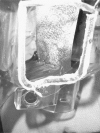Pharmacodynamic and efficacy profile of TGN 255, a novel direct thrombin inhibitor, in canine cardiopulmonary bypass and simulated mitral valve repair
- PMID: 18705547
- PMCID: PMC4680632
Pharmacodynamic and efficacy profile of TGN 255, a novel direct thrombin inhibitor, in canine cardiopulmonary bypass and simulated mitral valve repair
Abstract
Heparin-induced thrombocytopenia can be a life-threatening sequel to conventional use of unfractionated heparin in cardiopulmonary bypass (CPB). This study evaluated the pharmacokinetic/pharmacodynamic (PK/PD) and efficacy profile of a novel direct thrombin inhibitor, TGN 255, during cardiac surgery in dogs. Point-of-care coagulation monitoring was also compared against the plasma concentrations of TRI 50c, the active metabolite of TGN 255. The study was conducted in three phases using 10 animals: phase 1 was a dose-ranging study in conscious animals (n = 6), phase 2 was a similar but terminal dose-ranging study in dogs undergoing CPB (n = 6), and phase 3 was with animals undergoing simulated mitral valve repair (terminal) using optimal TGN 255 dose regimens derived from phases I and II (n = 4). During the study, PD markers and drug plasma levels were determined. In addition, determinations of hematologic markers and blood loss were undertaken. Phase 1 studies showed that a high-dose regimen of a 5-mg/kg bolus and infusion of 20 mg/kg/h elevated PD markers in conscious animals, at which time there were no measured effects on platelet or red blood cell counts, and the mean plasma concentration of TRI 50C was 20.6 microg/mL. In the phase 2 CPB dose-ranging study, this dosing regimen significantly elevated all the PD markers and produced hemorrhagic and paradoxical thrombogenic effects. In the phase 3 surgical study, a lower TGN 255 dose regimen of a 2.5-mg/kg bolus plus 10 mg/kg/h produced anticoagulation, elevated PD markers, and produced minimal post-operative blood loss in the animals. Plasma levels of TRI 50C trended well with the conventional point-of-care coagulation monitoring. TGN 255 provided effective anticoagulation in a canine CPB procedure, enabling successful completion with minimal blood loss. These findings support further evaluation of TGN 255 as an anticoagulant for CPB.
Conflict of interest statement
The senior author has stated that authors have reported no material, financial or other relationship with any healthcare-related business or other entity whose products or services are discussed in this paper.
Figures







Similar articles
-
Investigation of a thrombin inhibitor peptide as an alternative to heparin in cardiopulmonary bypass surgery.Circulation. 1993 Nov;88(5 Pt 2):II407-12. Circulation. 1993. PMID: 7993389
-
Heparinless cardiopulmonary bypass with argatroban in dogs.Eur J Cardiothorac Surg. 2004 May;25(5):819-24. doi: 10.1016/j.ejcts.2004.01.023. Eur J Cardiothorac Surg. 2004. PMID: 15082288
-
Heparin-level-based anticoagulation management during cardiopulmonary bypass: a pilot investigation on the effects of a half-dose aprotinin protocol on postoperative blood loss and hemostatic activation and inflammatory response.Anesth Analg. 2004 Feb;98(2):285-290. doi: 10.1213/01.ANE.0000096260.35340.C5. Anesth Analg. 2004. PMID: 14742356 Clinical Trial.
-
Anticoagulation and anticoagulation reversal with cardiac surgery involving cardiopulmonary bypass: an update.J Cardiothorac Vasc Anesth. 1999 Aug;13(4 Suppl 1):18-29; discussion 36-7. J Cardiothorac Vasc Anesth. 1999. PMID: 10468245 Review.
-
Avoidance of bleeding during surgery in patients receiving anticoagulant and/or antiplatelet therapy: pharmacokinetic and pharmacodynamic considerations.Clin Pharmacokinet. 2004;43(14):963-81. doi: 10.2165/00003088-200443140-00002. Clin Pharmacokinet. 2004. PMID: 15530128 Review.
References
-
- Hyers TM.. Management of venous thromboembolism: past, present, and future. Arch Intern Med. 2003;163:759–68. - PubMed
-
- Spiess BD.. Update on heparin-induced thrombocytopenia and cardiovascular interventions. Semin Hematol. 2005;42:S22–7. - PubMed
-
- Rice L.. Evolving management strategies for heparin-induced thrombocytopenia. Semin Hematol. 2005;42:S15–21. - PubMed
-
- Deitcher SR, Carman TL.. Heparin-induced thrombocytopenia: natural history, diagnosis, and management. Vasc Med. 2001;6:113–9. - PubMed
-
- Warkentin TE, Sheppard JA, Horsewood P, et al. . Impact of the patient population on the risk for heparin-induced thrombocytopenia. Blood. 2000;96:1703–8. - PubMed
MeSH terms
Substances
LinkOut - more resources
Full Text Sources
Medical
Miscellaneous
